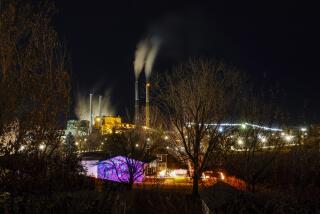Iron Ore Production Is Fired Up Again in Minnesota : Mining: Seven plants are spewing out low-grade ore in an area that lost 10,000 jobs after a near decade-long recession.
- Share via
MOUNTAIN IRON, Minn. — When a busload of visiting dignitaries toured the mammoth USX Minntac mine recently, the tour guide urged a quick visit to avoid traffic jams from changing shifts.
Not the image one would expect of a region that lost 10,000 mining jobs after a near decade-long recession.
Yet the Iron Range, which includes northeastern Minnesota and part of northern Michigan, still produces 77% of the nation’s iron ore. Seven plants are busily spewing out taconite pellets, a low-grade iron ore used in blast furnaces, and bracing for even more production increases.
“What’s left of the Iron Range is pretty damn solid,” said Peter Kakela, a Michigan State University professor who studies ore production. “It’s a wonderful story, and I think it needs to be told a bit more.”
Adding to the enthusiasm is Northwest Airlines’ recently announced plan to build an engine-overhaul facility in Hibbing by 1994 and a maintenance base in Duluth by 1993, generating at least 650 jobs initially. That’s small in comparison to the region’s 6,500 mining jobs yet welcome relief for some of the 3,867 area jobless.
Roger Johnson, assistant director of the mineral division for the state Department of Natural Resources, said the abundance of ore in northern Minnesota easily could keep the business alive for the next 50 years, and possibly 150 years.
“A lot of people don’t know we’re No. 1 in the domestic ore industry,” Johnson said. “We’re the player on the continent. Our friends down in the cities heard about the slowdown in the early ‘80s, and they don’t realize we bounced back,” he said.
Iron Range mines are expected to produce 42.5 million tons of taconite pellets this year, down from 44.5 million tons in 1990. But production increases are planned for 1992, Johnson said.
A recent industry report by PaineWebber Inc. predicted continued productivity improvements at Minnesota pellet plants.
Drastic labor cuts and operational changes after the 1981-82 recession had cut the cost of taconite pellets from $48 a ton in 1982 to $29 a ton in 1988. And productivity slipped about 9% since it peaked in 1987.
But by 1995, boosted by a surge in demand, productivity should return to the 1987 level, the PaineWebber report said.
At the same time, wages and benefits should increase from the current average of $25.43 an hour in the Minnesota mines to $29 an hour, the report said.
For those gains to be made, however, another 690 jobs would be trimmed in the next five years, it said.
“That sounds like a lot, but it’s not that much more to cut,” said Michigan State’s Kakela, a consultant on the report.
Dermot Pogson, general manager of the USX Minntac plant, said demand for ore is up. But he said it’s not wise to make long-range forecasts about the industry because its fate rests with domestic steel.
“We’re a lot better off than we used to be, but the steel business is practically a basket case,” Pogson said. “People should look at the health of steel companies.”
More to Read
Inside the business of entertainment
The Wide Shot brings you news, analysis and insights on everything from streaming wars to production — and what it all means for the future.
You may occasionally receive promotional content from the Los Angeles Times.









